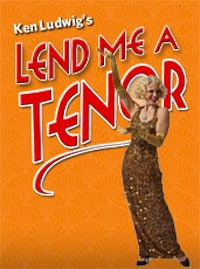
![]() by Michael Sommers
by Michael Sommers
read review on nytimes.com
One of the nicest features of the Broadway revival of Ken Ludwig’s “Lend Me a Tenor” back in 2010 was John Lee Beatty’s creamy rococo hotel suite where the operatic characters dashed about.
The Paper Mill Playhouse’s exuberant staging of “Lend Me a Tenor” in Millburn utilizes Mr. Beatty’s set, which provides five doors that always slam with a satisfying wham. Within those deluxe surroundings, the theater presents a fresh, expertly performed rendition of Mr. Ludwig’s well-known farce.
This 1986 play has long been a perennial among regional and community theaters, and with good reason. Employing some of the traditional elements from hotel-room farces of past centuries — mistaken identities, sexy ladies, naughty banter, looming scandal — the playwright crafted a frisky 1930s-style comedy that demands only stylish performances to be considerable fun.
The director, Don Stephenson, has assembled a smart cast to do exactly that at Paper Mill. Theatergoers who already know the show may even enjoy it more than the newcomers, since they can anticipate some of its antics.
Occupying that hotel suite one night in 1934 is Tito Merelli (John Treacy Egan), a celebrated Italian tenor who is making his long-awaited American debut in “Otello” with the Cleveland Grand Opera Company. Saunders (Michael Kostroff), the company’s pompous general manager, and Max (David Josefsberg), his milquetoast assistant and a would-be singer, quickly have their hands full with Tito, a lover of wine, women and song whose florid charms have the local ladies in a flutter.
A jealous blowup between Tito and Maria (Judy Blazer), his spitfire wife, combined with an unwise excess of Chianti and sedatives, plunges the overly emotional tenor into a coma that Saunders and Max believe is fatal. Soon Max is disguised in Tito’s brocade doublet and swarthy makeup as Otello and rushes off to perform the opera, at which point Tito wakes up. Matters turn increasingly frantic and funny later as look-alikes Tito and Max cope with several smitten females and other confusions.
Mr. Stephenson guides the comedy briskly through its paces while encouraging sterling performances that reflect the animated style displayed by silver-screen worthies. The bespectacled Mr. Josefsberg brings a wistful countenance and an energetic manner to his underdog role as Max. The portly Mr. Kostroff, whose Saunders is an amalgam of several 1930s character actors, complete with a pencil-style mustache and bulging eyeballs, looks thoroughly overbearing or staggered as the plot requires.
A tall, imposing figure as Tito, Mr. Egan portrays the tenor with a ringing voice and a good-natured air. Infusing her ferocious Maria with a pepperoni accent for frequently hissed threats like “I’m gonna keel ’im,” the invaluable Ms. Blazer sulks and stomps through the same role she played in the Paper Mill’s 1991 production and makes it all seem spontaneous.
The other women, beautifully dressed (and sometimes undressed) by Wade Laboissonniere in period fashions, brightly depict their characters. Jill Paice (the ingénue), Nancy Johnston (the dowager) and Donna English (the femme not-so-fatale) all pursue the opera star — or at least the fellow they believe to be Tito. Mark Price dashes in and out as a cheeky bellhop who can’t help singing, despite everyone’s wishes.
In such fine company, you can’t help laughing a lot at “Lend Me a Tenor.”

Comments are closed.